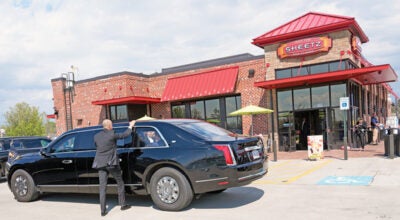Meth lab training teaches awareness
Published 9:47 am Tuesday, April 2, 2013
It can cost as little as $40 to make and many of the ingredients may already be in your own home.
Harmless when used for their intended purposes, the chemicals used to make methamphetamine are available at any retail or hardware store.
So how can you tell when those products are being used to manufacture one of the most abused drugs on the planet?
Dennis Lowe, senior special agent with Ohio’s Bureau of Criminal Investigation, gave life-saving tips Monday to law enforcement personnel, first responders, home care and children’s services workers on how to spot potential meth labs, the hazards and how to respond to the situation.
“This drug, unlike any other drug I have encountered in my career, has a really unique ability to impact our community in a very negative way,” Lowe said.
Last year, about 1,000 meth labs were seized in the state of Ohio, more than twice as many as in 2011.
To make matters worse, about 75 percent of those meth labs seized in 2012 were found inadvertently by home health workers, sanitarians, retail workers and other non-law enforcement civilians.
Debbie Elliott, regional public health preparedness coordinator based out of Hocking County, said she coordinated Lowe to speak in seven counties in southern Ohio.
“We need to prepare people who go into homes so they can have a clue that something is going on,” Elliott said.
For that reason, Lowe taught the audience in the Ohio University Southern Bowman Auditorium how to recognize the signs of a meth addict and how they act as well as the components of a meth lab.
“You have this stuff in your own homes,” Lowe said. “So what does it look like when you go into other people’s homes and see it?”
Where are meth labs found?
The answer was as simple as it was complicated — anywhere.
The drug is domestically produced, unlike cocaine, so meth labs can be found in rural, urban and suburban areas. It can be found in parking lots, in cars, in parks and even in the retail stores where the ingredients were purchased.
For home care workers, like those from the Lawrence County Early Childhood Academy, spotting meth-making materials in client’s homes could be life saving for the children involved.
Lowe said children are found in about 70 percent of homes where the meth labs are seized.
“The vast majority of those children, if they were tested, would test positive for methamphetamine,” Lowe said. “The vapors end up on counter tops, in the carpet, in the food, clothes, toys. And where does everything a kid touch end up? Right in their mouth.”
Phyllis Newman, family and community partnership manager with the LCECA, said the statistics were disturbing.
“I think we just still don’t know how severe it is in our county,” Newman said.
Newman said at least a dozen Head Start and Help Me Grow workers visit homes weekly. In the past, some have reported odors to children’s services that did turn out to be meth labs.
“We want them to use their eyes and ears,” Newman said. “We want to build a relationship with the families.”
Lowe said there are three simple questions to ask when determining if there is a meth lab in a home.
What are the locations of the potential meth ingredients?
“It is not illegal to own starter fluid and Mason jars but when they are in your closet next to your police scanner … You’ve just got to be paying attention,” Lowe said, showing a photo from a meth lab.
In what quantities are the potential meth ingredients?
One bottle of drain cleaner found under the kitchen sink is normal, but three bottles found sitting out in the bedroom on a dresser, not so normal, Lowe said.
The last question being, are the potential meth ingredients found in any combination?
“When you start seeing things that are used to make meth in places you shouldn’t be seeing it, then you see it in any kind of combination with other stuff people use to make meth, it’s a meth lab,” Lowe said.
And always err on the side of caution, Lowe said.
Other indicators Lowe cautioned people to watch for were jars or containers with solids and liquids in the same container, coffee filters that appear to be stained with something other than coffee grounds, soda bottles with sludge in the bottom and tubing and empty cold medicine blister packs.
Lowe also talked about how to identify certain types of meth labs. The most popular method in Ohio is the relatively new “shake-and-bake method,” Lowe said.
Whereas other methods require more ingredients and longer “cook” times, the meth made using the shake-and-bake method takes fewer ingredients which produces a higher yield, all in a fraction of the time.
All of the recent labs found in Lawrence County, Lowe said, were using this method, which is extremely dangerous, even after the materials are discarded.
Last year, a Kentucky man led police on a two-state chase that ended on Lawrence Street in Ironton. A mobile meth lab was found in the vehicle.
The Ironton Fire Department responded to the incident, said Chief Tom Runyon. Runyon and other firefighters were at the seminar Monday.
“It’s scary what’s out there,” Runyon said.
The fire department frequently enters homes for emergency and non-emergency situations. He said knowing how to spot the dangers of meth would help protect the crew.
Lowe cautioned the crowd not to touch, sniff or open anything suspected in the making of meth. He advised them to contact law enforcement who would in turn contact BCI or another agency.
Right now, one Lawrence County Sheriff’s Office deputy is certified to identify meth labs. Lowe said another is going through training.




